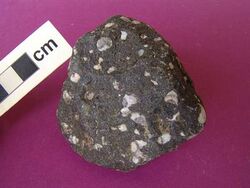Chemistry:Spilite
Spilite (from Greek: σπιλάς) is a fine-grained igneous rock, resulting particularly from alteration of oceanic basalt.
The term was introduced into the geological literature by Alexandre Brongniart in 1827.[1] Spilite is formed when basaltic lava reacts with seawater, or from hydrothermal alteration when seawater circulates through hot volcanic rocks.[2]
It is a metasomatic rock with a microscopic or very-fine grain size produced by hydrothermal alteration of basalt, and composed of albite or oligoclase, together with chlorite, epidote, calcite, and actinolite.[3] Spilite is veined by calcite or chalcedony, and vesicles and cavities are filled with secondary minerals.[2] It is generally classed with basalts, and it often retains many textural and structural features characteristic of basalt.[3]
See also
- Earth:Pillow lava – Lava containing characteristic pillow-shaped structures due to subaqueous extrusion
Notes
- ↑ Manfred Schidlowski: Spilite and the basal tables volcanism. Natural sciences, Bd. 56, No. 10, P. 488-493, Springer publishing house, Berlin/Heidelberg 1969, ISSN 0028-1042
- ↑ 2.0 2.1 Monica Price, Kevin Walsh, Pocket Nature, Rocks and Minerals, page 63. Dorling Kindersley.
- ↑ 3.0 3.1 McGraw-Hill encyclopedia of the geological sciences, page 793
 |


